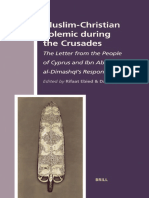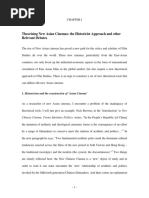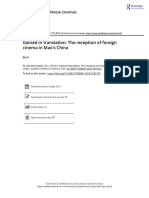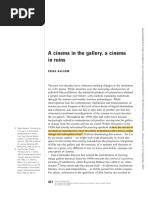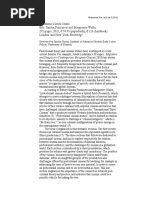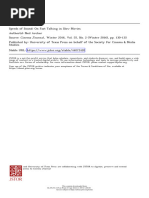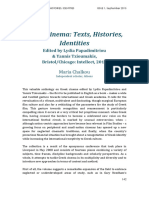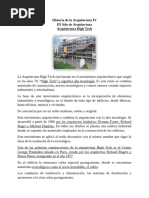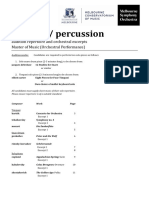Global Art Cinema
Global Art Cinema
Uploaded by
Barbara MissoCopyright:
Available Formats
Global Art Cinema
Global Art Cinema
Uploaded by
Barbara MissoOriginal Title
Copyright
Available Formats
Share this document
Did you find this document useful?
Is this content inappropriate?
Copyright:
Available Formats
Global Art Cinema
Global Art Cinema
Uploaded by
Barbara MissoCopyright:
Available Formats
Review
Reviewed Work(s): Global Art Cinema: New Theories and Histories by Rosalind Galt and
Karl Schoonover
Review by: Lisa Patti
Source: Film Criticism , Winter, 2011/12, Vol. 36, No. 2 (Winter, 2011/12), pp. 78-80
Published by: Allegheny College
Stable URL: https://www.jstor.org/stable/24777826
JSTOR is a not-for-profit service that helps scholars, researchers, and students discover, use, and build upon a wide
range of content in a trusted digital archive. We use information technology and tools to increase productivity and
facilitate new forms of scholarship. For more information about JSTOR, please contact support@jstor.org.
Your use of the JSTOR archive indicates your acceptance of the Terms & Conditions of Use, available at
https://about.jstor.org/terms
Allegheny College is collaborating with JSTOR to digitize, preserve and extend access to Film
Criticism
This content downloaded from
91.82.60.50 on Sat, 04 Mar 2023 23:29:56 UTC
All use subject to https://about.jstor.org/terms
Global Art Cinema: New Theories and Histories
Rosalind Gait and Karl Schoonover, eds.
New York: Oxford University Press, 2010.
Reviewed by Lisa Patti
In their introduction to the anthology Global Art Cinema:
New Theories and Histories, Rosalind Gait and Karl Schoonover
acknowledge the ambivalence that the term "art cinema" produces,
noting that "many scholars to whom we spoke about this volume
responded with perplexity that we would endorse such a retrograde
category"(5). The introduction confronts this ambivalence with
a rigorous and at times polemical argument in favor of a scholarly
reappraisal of art cinema in its past and present iterations.
The recuperation of art cinema as an industrial, aesthetic,
and critical category relies on the combination of "art cinema" with
"global" - an equally controversial term, generating the anthology's
focus on "global art cinema." In this formulation, "global" operates
not as a modifier, designating a subset of art cinema, but as an essential
element of art cinema: "The term 'global' speaks to the international
address, distribution, audience, and aesthetic language of the art
cinema. This globality is, however, enabled by the term 'art,' which
connects ideas about the status of the image to international aesthetic,
critical, and industrial institutions"(20).
The excellent introduction not only frames the anthology's
discussion of global art cinema but also offers a long-overdue account
of the aesthetic, industrial, and political contours and consequences
of art cinema. The introduction - like many of the essays that follow
- cites David Bordwell's "Art Cinema as a Mode of Film Practice"
(1979) - first published in Film Criticism - and Steve Neale's "Art
Cinema as Institution" (1981) - as primary critical reference points.
The anthology traces the shifting global networks of film production,
distribution, and reception in the decades since those essays were first
published, underscoring the value of issuing a new set of claims about
the status of art cinema. The introduction enlivens the discussion of
art cinema, defending art cinema's "investment in visual legibility and
cross-cultural translation"( 10) as a universality that "enables us to
think about the global"(l 1).
Gait and Schoonover buttress their definition of art cinema
in relation to the global by outlining the critical value of art cinema's
78
This content downloaded from
91.82.60.50 on Sat, 04 Mar 2023 23:29:56 UTC
All use subject to https://about.jstor.org/terms
various impurities, captured in the introduction's subtitle - "The
Impurity of Art Cinema." They argue that art cinema's impurity
assumes five forms: its occupation of impure institutional spaces,
caught between commercial and experimental or avant-garde cinemas;
its imprecise relationship to national cinemas and international cinema,
often defined as "foreign" and in transit; its ambivalent relationship to
the dominant structuring categories of film culture, including stardom
and authorship; its imperfect fit within genres or as a genre; and its
nrarlnr»ti r\r» at-» imni irp nr "lirrKrirl" cnpofatnr
The essays gathered in Global Art Cinema deploy a range
methodological approaches to analyze the impurities of art cinem
with contributions focused on individual directors, films, ge
and industrial formations. While the collection is divided into four
relatively coherent sections - Delimiting the Field, The Art Cinema
Image, Art Cinema Histories, and Geopolitical Intersections -
emphases on style and circulation emerge across these sections.
In the anthology's opening essay and one of its most sustained
meditations on style, Mark Betz renovates David Bordwell's definition
of "parametric narration," arguing that "local knowledges are inflected,
indeed even explicitly foregrounded as such, by parametric form,"
and locating, in the global parametric art cinema tradition (which
includes Abbas Kiarostami, Carlos Reygadas, and Abderrahmane
Sissako), "aesthetic features that attest to the persistence of cinematic
modernism, with a difference, in the so-called postmodem era of
globalization"(32-33). Betz's intervention comes alive in the closing
pages of the essay in his close reading of Wong Kar-Wai's In the Mood
for Love (2000), in which he demonstrates the pleasure of "cracking"
the film's parametric codes.
The focus on style in Betz's essay surfaces in a different form
in John David Rhodes' "Pasolini's Exquisite Flowers: The 'Cinema of
Poetry' as Theory of Art Cinema." Dwelling on Pasolini's "theorization
of style as the very medium of appearance of political consciousness
in the cinema"(155), as articulated in his often-maligned essay "The
'Cinema of Poetry,"' Rhodes manages to translate some of the most
opaque moments in Pasolini's essay and uncovers the alliance that
Pasolini forges between art cinema and "the cinema of poetry."
The collected essays advance the discussion of both global
cinema and art cinema and the areas of intersection marked in the
volume's introduction. Global Art Cinema seeks to inaugurate a new
79
This content downloaded from
91.82.60.50 on Sat, 04 Mar 2023 23:29:56 UTC
All use subject to https://about.jstor.org/terms
form of scholarship on art cinema, attentive to the combinations of
industry, history, and textuality that Gait and Schoonover cite as urgent
components of any discussion of global art cinema.
Among the many fine essays in the collection, the contributions
of Azadeh Farahmand and Jean Ma stand out as exemplary for the
manner in which they seamlessly merge these modes of analysis.
Farahmand's methodologically textured discussion of the two waves
of Iranian art cinema defined by the "circuits" of international film
festivals charts the industrial and aesthetic influence of festivals on the
definition of Iranian cinema as a national cinema and the circulation
of Iranian cinema beyond national borders. The importance of
international film festivals to global art cinema emerges in other essays
throughout the collection, suggesting that an anthology devoted to that
subtopic would be a productive project.
Jean Ma, focusing on the comparative impulse within the
critical reception of global art cinema, discusses the role of the auteur
in global art cinema, examining the importance of new forms of
intertextuality in Tsai Ming-liang's films and his excessive performance
of his own authorship. She argues that the layered intertextuality
within his films "intensifies the already-heightened textual presence
of the director that marks the art film genre"(346).
While the discussion of global cinema now preoccupies many
corners of film scholarship, the sustained attention to global art cinema
in this anthology provides a welcome contribution to this expanding
field. The collection has a global reach - from Jihoon Kim's analysis
of the spatial relations within and among Thai filmmaker Apichatpong
Weerasethakul's feature films and video installations, to Dennis
Hanlon's assertion that the work of Bolivian filmmaker Jorge Sanjinés
reveals an engagement with European art cinema within New Latin
American Cinema. The range of films and national and transnational
film traditions discussed is not comprehensive (no single volume
could map the breadth of what "global art cinema" designates), but
the list of films cited is snfmestive
The otherwise very reader-friendly organization of the book
would have benefited from the inclusion of a filmography to capture the
range of films discussed in a single snapshot, not in order to formalize
an incomplete canon of global art cinema but to bring those films into
closer proximity and encourage further comparative analyses. Global
Art Cinema successfully recuperates "art cinema" and introduces
"global art cinema" as a new term for discussion and debate.
80
This content downloaded from
91.82.60.50 on Sat, 04 Mar 2023 23:29:56 UTC
All use subject to https://about.jstor.org/terms
You might also like
- Rethinking Genre Christine GledhillDocument24 pagesRethinking Genre Christine GledhillPaula_LobNo ratings yet
- The Essay Film From Montaigne After MarkerDocument244 pagesThe Essay Film From Montaigne After Markeryu100% (1)
- Menagerie: Teeny TinyDocument124 pagesMenagerie: Teeny TinyLeila Azevedo100% (16)
- Shonini Chaudhuri - Contemporary World Cinema Europe, The Middle East, East Asia and South AsiaDocument203 pagesShonini Chaudhuri - Contemporary World Cinema Europe, The Middle East, East Asia and South AsiaMikes Jetigan50% (2)
- DeValck Loist 2009 FilmFestivalStudies DoublepageDocument19 pagesDeValck Loist 2009 FilmFestivalStudies DoublepageĐurđija RadivojevićNo ratings yet
- Fowler, Catherine - Room For Experiment. Gallery Films and Vertical Time From Maya Deren To Eija Liisa AhtilaDocument20 pagesFowler, Catherine - Room For Experiment. Gallery Films and Vertical Time From Maya Deren To Eija Liisa AhtilaDaniel Tercer MundoNo ratings yet
- (Xuelin Zhou (Auth.) ) Globalization and Contempora PDFDocument138 pages(Xuelin Zhou (Auth.) ) Globalization and Contempora PDFKellerMirellaNo ratings yet
- Muslim-Christian Polemic During The Crusades The Letter From The People of Cyprus and Ibn Abi Talib Al-Dimashqi's Response PDFDocument525 pagesMuslim-Christian Polemic During The Crusades The Letter From The People of Cyprus and Ibn Abi Talib Al-Dimashqi's Response PDFHiroNo ratings yet
- Toscano Reviews Ranciere On TarrDocument4 pagesToscano Reviews Ranciere On Tarrtomkazas4003No ratings yet
- Rethinking The Canon The Role of Film Festivals in Shaping Film HistoryDocument16 pagesRethinking The Canon The Role of Film Festivals in Shaping Film Historywenminshi976No ratings yet
- Filmmaking. Princeton: Princeton UP, 2001.: Uploaded 25 July 2002 1727 WordsDocument9 pagesFilmmaking. Princeton: Princeton UP, 2001.: Uploaded 25 July 2002 1727 WordsEran SaharNo ratings yet
- WALLEY IdentityCrisisExperimental 2011Document29 pagesWALLEY IdentityCrisisExperimental 2011zrzhong13No ratings yet
- Jonathan Walley - The Material of Film and The Idea of Cinema. Contrasting Practices in Sixties and SeventiesDocument17 pagesJonathan Walley - The Material of Film and The Idea of Cinema. Contrasting Practices in Sixties and Seventiesdr_benway100% (1)
- Art Cinema - Narration Breaking Down A Wayward ParadigmDocument13 pagesArt Cinema - Narration Breaking Down A Wayward Paradigmsolodudas100% (1)
- Introducing Transnational Cinemas - Shaw y de La GarzaDocument4 pagesIntroducing Transnational Cinemas - Shaw y de La GarzarigobertigoNo ratings yet
- PENLEY, Constance BERGSTROM, Janet. The Avant-Garde Histories and TheoriesDocument16 pagesPENLEY, Constance BERGSTROM, Janet. The Avant-Garde Histories and TheoriesNataliaNo ratings yet
- Transworld Cinemas - David Martin-JonesDocument11 pagesTransworld Cinemas - David Martin-Jonesozen.ilkimmNo ratings yet
- Deborah Shaw - Deconstructing and Reconstructing Transnational CinemaDocument20 pagesDeborah Shaw - Deconstructing and Reconstructing Transnational CinemamarcelabrNo ratings yet
- A Cinema in The Gallery, A Cinema in Ruins: ErikabalsomDocument17 pagesA Cinema in The Gallery, A Cinema in Ruins: ErikabalsomD. E.No ratings yet
- Asian CinemaDocument66 pagesAsian CinemanutbihariNo ratings yet
- Critical Formation of Hong Kong Noir. Historiographical and Methodological ReflectionsDocument18 pagesCritical Formation of Hong Kong Noir. Historiographical and Methodological ReflectionsJohnson LeowNo ratings yet
- 3088886Document24 pages3088886Dario BordinNo ratings yet
- JCC Gained in Translation PDFDocument16 pagesJCC Gained in Translation PDFJie LiNo ratings yet
- Baumann 2001Document26 pagesBaumann 2001陳誌頤No ratings yet
- Balsom - A Cinema in The GalleryDocument17 pagesBalsom - A Cinema in The Gallery譚安尼No ratings yet
- The Longitude and Latitude of World Cinema: Rob Stone, Paul Cooke, Stephanie Dennison and Alex Marlow-MannDocument20 pagesThe Longitude and Latitude of World Cinema: Rob Stone, Paul Cooke, Stephanie Dennison and Alex Marlow-MannIvy Roberts100% (1)
- Simultaneous Worlds: Global Science Fiction CinemaDocument6 pagesSimultaneous Worlds: Global Science Fiction Cinemabegüm çelebiNo ratings yet
- Gnosis and Iconoclasm - A Case Study of CinephiliaDocument17 pagesGnosis and Iconoclasm - A Case Study of CinephiliaManoel FriquesNo ratings yet
- Pos Colonial CinemaDocument3 pagesPos Colonial CinemanandouferNo ratings yet
- Chinese Cinema and Transitional Cultural Politics: Rethinking Film Festivals, Films Productions, and Film StudiesDocument29 pagesChinese Cinema and Transitional Cultural Politics: Rethinking Film Festivals, Films Productions, and Film StudiesNieves VillasecaNo ratings yet
- A Cinema in The Gallery A Cinema in RuinsDocument17 pagesA Cinema in The Gallery A Cinema in RuinsjosepalaciosdelNo ratings yet
- Russell, Catherine, Japanese Cinema in The Global System: An Asian Classical CinemaDocument23 pagesRussell, Catherine, Japanese Cinema in The Global System: An Asian Classical CinemaChris DingNo ratings yet
- Francesco Casetti and Italian Film SemioticsDocument25 pagesFrancesco Casetti and Italian Film SemioticsinadequacaoNo ratings yet
- Global Cinema PresentationDocument9 pagesGlobal Cinema PresentationNatallia YeloshynaNo ratings yet
- 11 - Woody Allens Midnight in ParisDocument8 pages11 - Woody Allens Midnight in ParisMarcel SoaresNo ratings yet
- Art-House Cinema, Avant-Garde Film, and Dramatic ModernismDocument17 pagesArt-House Cinema, Avant-Garde Film, and Dramatic ModernismThisisLuizNo ratings yet
- World Cinema, Dudley Andrew: Staging of Globalization Provides Continuity For Us, and It Is Well WorthDocument4 pagesWorld Cinema, Dudley Andrew: Staging of Globalization Provides Continuity For Us, and It Is Well WorthnicosuarezNo ratings yet
- Futures of Chinese Cinema: Technologies and Temporalities in Chinese Screen CulturesFrom EverandFutures of Chinese Cinema: Technologies and Temporalities in Chinese Screen CulturesNo ratings yet
- INTRODUCTIONDocument5 pagesINTRODUCTIONdis556001No ratings yet
- Theories of Film Andrew Tudorpdf - CompressDocument170 pagesTheories of Film Andrew Tudorpdf - CompressDebanjan Bandyopadhyay100% (1)
- Kiarostami's Unfinished Cinema and Its Postmodern ReflectionsDocument15 pagesKiarostami's Unfinished Cinema and Its Postmodern ReflectionsJennifer Zurita PatronNo ratings yet
- 00-Trauma and Sensation - A Study of The Youth Icon in All About Lily Chou-Chou - 2001 - 2Document15 pages00-Trauma and Sensation - A Study of The Youth Icon in All About Lily Chou-Chou - 2001 - 2ssceng26No ratings yet
- A Film Aesthetic to DiscoverDocument26 pagesA Film Aesthetic to DiscoverRei AyanamiNo ratings yet
- Archer SpeedsSoundFast 2016Document7 pagesArcher SpeedsSoundFast 2016yuNo ratings yet
- 00-The Cinephilic Citation in The Essay Films by Jos - Luis Guerin and Isaki LacuestaDocument22 pages00-The Cinephilic Citation in The Essay Films by Jos - Luis Guerin and Isaki Lacuestadr_ardenNo ratings yet
- International Sociology-2006-Quemin-522-50Document30 pagesInternational Sociology-2006-Quemin-522-50Veronika VoytsitskaNo ratings yet
- This Content Downloaded From 109.49.166.49 On Fri, 01 Oct 2021 14:11:18 UTCDocument22 pagesThis Content Downloaded From 109.49.166.49 On Fri, 01 Oct 2021 14:11:18 UTChedehodoNo ratings yet
- The Berlin School and Its Global Contexts: A Transnational Art CinemaFrom EverandThe Berlin School and Its Global Contexts: A Transnational Art CinemaNo ratings yet
- Film Studies Critical Approaches IntroductionDocument8 pagesFilm Studies Critical Approaches IntroductionPaula_LobNo ratings yet
- The Fiction Nonfiction Distinction Documentary Studies and Analytic Aesthetics in ConversationDocument8 pagesThe Fiction Nonfiction Distinction Documentary Studies and Analytic Aesthetics in ConversationZaki NajimNo ratings yet
- Towards The Creation of Quality Greek NaDocument338 pagesTowards The Creation of Quality Greek NaNikos PapagiannoulisNo ratings yet
- Foreign Language Publications Modern Chinese Literature and CultureDocument34 pagesForeign Language Publications Modern Chinese Literature and CultureJingyi ZhangNo ratings yet
- The Open Image: Poetic Realism and The New Iranian CinemaDocument20 pagesThe Open Image: Poetic Realism and The New Iranian CinemajosepalaciosdelNo ratings yet
- Ria Thanouli, Post-Classical NarrationDocument15 pagesRia Thanouli, Post-Classical NarrationmentamentaNo ratings yet
- Hake GirlsCrisis 1987Document19 pagesHake GirlsCrisis 1987X1ndyNo ratings yet
- BaumannDocument23 pagesBaumann陳誌頤No ratings yet
- Book Review - Papadimitriou&Tzioumakis, Greek CinemaDocument10 pagesBook Review - Papadimitriou&Tzioumakis, Greek CinemakxrysogelosNo ratings yet
- Anarchy in The PRC Meng Jinghui and His Adaptation of Dario Fo's Accidental Death of An Anarchist PDFDocument49 pagesAnarchy in The PRC Meng Jinghui and His Adaptation of Dario Fo's Accidental Death of An Anarchist PDFdiaiguNo ratings yet
- Hamish Ford The Return of The 1960s Modernist CinemaDocument16 pagesHamish Ford The Return of The 1960s Modernist CinemaleretsantuNo ratings yet
- GIAF21 ProgrammeDocument52 pagesGIAF21 ProgrammeThe Journal of MusicNo ratings yet
- The Loosening Role of Polyphony TextureDocument32 pagesThe Loosening Role of Polyphony TextureVitor Giovannitti100% (1)
- RenaissanceDocument2 pagesRenaissanceVon DiocenaNo ratings yet
- Parts List For Apollo LUT V1.2.LxfDocument13 pagesParts List For Apollo LUT V1.2.LxfOliver PinedaNo ratings yet
- Comparing Traditional and Modern Trends in Jazz ImprovisationDocument78 pagesComparing Traditional and Modern Trends in Jazz Improvisationkracker43100% (2)
- Music Orientation Schedule 2020Document9 pagesMusic Orientation Schedule 2020joseNo ratings yet
- Arquitectura High TechDocument7 pagesArquitectura High TechNahomi FajardoNo ratings yet
- Erik 1924Document2 pagesErik 1924Miguel AngelNo ratings yet
- Commercial Parody SummativeDocument3 pagesCommercial Parody Summativeapi-283484194No ratings yet
- Function of ArtDocument2 pagesFunction of ArtAra JeanNo ratings yet
- Midterm Test Gateway BDocument5 pagesMidterm Test Gateway BEduarda Rabello0% (1)
- MAPEH 7 Q4 Week 6Document7 pagesMAPEH 7 Q4 Week 6Adrian PenaredondoNo ratings yet
- Unit 1 ScriptDocument7 pagesUnit 1 Scriptapi-488197325No ratings yet
- Mrs Dalloway CharacterDocument3 pagesMrs Dalloway Characterreshmimahato437No ratings yet
- The Moment of PsychoDocument193 pagesThe Moment of PsychoDumitru DascalescuNo ratings yet
- The Full EightsDocument10 pagesThe Full EightsKurt HennigNo ratings yet
- Project: Proposed (G) Car Wash: Owner'S NameDocument18 pagesProject: Proposed (G) Car Wash: Owner'S NameMØhãmmed ØwięsNo ratings yet
- Emotional Geographies 2 - Preview-9781317144649 - A26853509Document34 pagesEmotional Geographies 2 - Preview-9781317144649 - A26853509pepita del marNo ratings yet
- English Part 3Document17 pagesEnglish Part 3Chynna Ulep AlbertNo ratings yet
- Timpani and Percussion PDFDocument18 pagesTimpani and Percussion PDFPepe VillaNo ratings yet
- LatsoDocument9 pagesLatsoVINCENT PRASAKTINo ratings yet
- SerpaDocument8 pagesSerpamohammedNo ratings yet
- Elizabeth Sears - Warburg's - Hertziana - LectureDocument22 pagesElizabeth Sears - Warburg's - Hertziana - LectureTimajosNo ratings yet
- (Magazine - Wood - Eng) Woodsmith #100 Vol 17 (Aug 1995) Classic Workbench - (Special Edition) PDFDocument30 pages(Magazine - Wood - Eng) Woodsmith #100 Vol 17 (Aug 1995) Classic Workbench - (Special Edition) PDFPaweł JamrożekNo ratings yet
- Session 4-Art ExhibitionDocument37 pagesSession 4-Art ExhibitionCrisencio M. PanerNo ratings yet
- Architecture of London Preparatory MaterialsDocument22 pagesArchitecture of London Preparatory MaterialsMaximo Cusihuata ChoqueNo ratings yet
- Hello Kitty Crochet Book-InglésDocument16 pagesHello Kitty Crochet Book-InglésvaldezastoreNo ratings yet
- Define Fundamental Rhythms of DanceDocument2 pagesDefine Fundamental Rhythms of DanceNnayduj DgdgNo ratings yet







